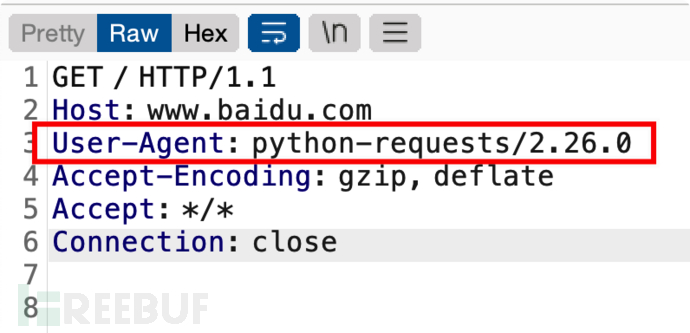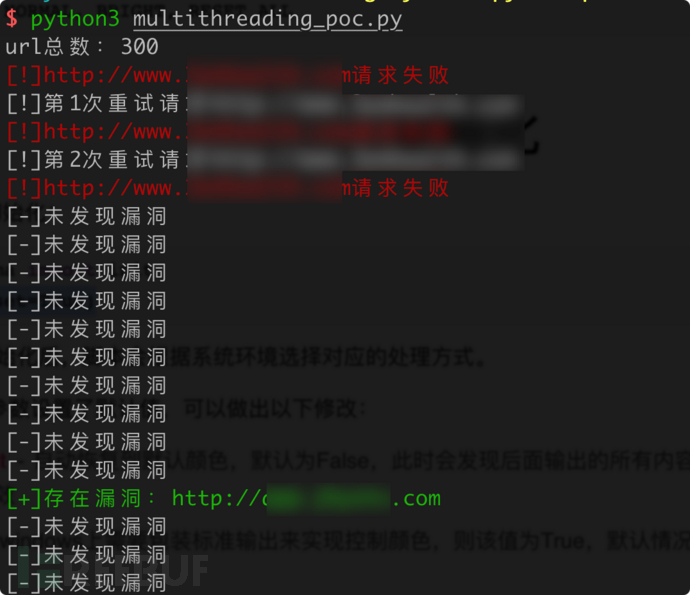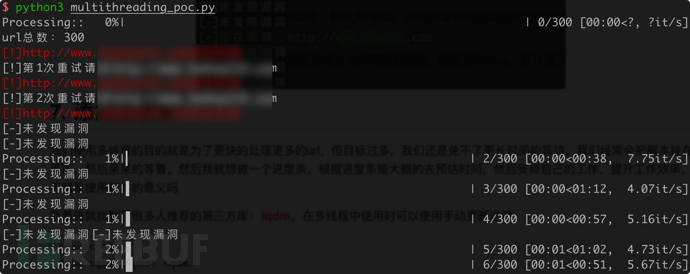

如何编写Python漏洞验证脚本(单线程和多线程)
source link: https://www.freebuf.com/sectool/319059.html
Go to the source link to view the article. You can view the picture content, updated content and better typesetting reading experience. If the link is broken, please click the button below to view the snapshot at that time.
我们实战经常会遇到以下几个问题:
1、遇到一个利用步骤十分繁琐的漏洞,中间错一步就无法利用
2、挖到一个通用漏洞,想要批量刷洞小赚一波,但手动去测试每个网站工作量太大
这个时候编写一个poc脚本将会将会减轻我们很多工作。本文将以编写一个高效通用的poc脚本为目的,学习一些必要的python知识,这周也是拒绝做工具小子努力学习的一周
requests模块使用技巧
Requests是Python中一个常用的HTTP请求库,使用Requests库来发起网络请求非常简单,具体的使用方法这里就不多介绍了,这里只提几个Requests模块的使用技巧,请收好
取消重定向
Requests 会自动处理所有重定向,但有时我们并不需要重定向,可以通过allow_redirects参数禁用重定向处理:
r = requests.get('http://github.com', allow_redirects=False)
SSL 证书验证
Requests在请求https网站默认会验证SSL证书,可有些网站并没有证书,可增加verify=False参数忽略证书验证,但此时可能会遇到烦人的InsecureRequestWarning警告消息。最终能没有警告消息也能访问无证书的https网站的方法如下:
import requests
from requests.packages.urllib3.exceptions import InsecureRequestWarning
requests.packages.urllib3.disable_warnings(InsecureRequestWarning)
requests.get('https://github.com', verify=False)
代理
使用代理的目的就不说了,使用方法如下:
# http代理,需要指定访问的http协议和https协议两种
proxies = {
"http": "http://127.0.0.1:8080",
"https": "http://127.0.0.1:1080",
}
# socks5代理
proxies = {
'http': 'socks5://user:pass@host:port',
'https': 'socks5://user:pass@host:port'
}
requests.get("http://example.org", proxies=proxies)
有个使用技巧就是代理到burp中,检查一下python发包。如我本地抓到requests请求包如下,可以发现特征十分明显,所以我们在实战使用时尽量修改User-Agent

保持cookie
使用session会话对象,向同一主机发送多个请求,底层的 TCP 连接将会被重用,不仅能提性能还能保持cookie
s = requests.Session()
s.get('http://httpbin.org/cookies/set/sessioncookie/123456789')
r = s.get("http://httpbin.org/cookies")
在编写poc脚本时我们只需要利用Requests模块发送带有payload的数据即可,配合上这里的小技巧可能会有更好的体验
发送带有payload的请求后,我们需要通过分析响应包判断是否存在漏洞。往往存在漏洞的响应包都有一些特殊值,我们只需要在响应包中找到这样的特殊值即可证明存在漏洞,所以这里我们通常有两种写法
成员运算符 - in
if 'xxx' in r.text:
print('存在漏洞')
else:
print('不存在漏洞')
正则匹配 - re.search()
if re.search('xxx',r.text):
print('存在漏洞')
else:
print('不存在漏洞')
这两种写法差不多,不过re.search()有个好处是可以使用正则表达式,在漏洞特征是动态变化的情况时也能有效的捕捉
单线程poc脚本
此时我们已经能写一个单线程poc脚本了,我对单线程的poc脚本的要求十分简单,就是简单,在面对不同的漏洞时简单修改几行代码就可以了。这里提供一个我自己写的单线程poc脚本,大概意思就是这样
import requests
import re
from requests.packages.urllib3.exceptions import InsecureRequestWarning
requests.packages.urllib3.disable_warnings(InsecureRequestWarning)
def Poc(url):
proxy = {
'http':'http://127.0.0.1:8080',
'https':'http://127.0.0.1:8080'
}
headers = {
'User-Agent':'Mozilla/5.0 (Windows NT 10.0; Win64; x64) AppleWebKit/537.36 (KHTML, like Gecko) Chrome/92.0.4515.107 Safari/537.36',
'Connection':'close'
}
data = {'name':'xxxx','value':'xxxx'}
try:
response = requests.post(url=url,headers=headers,data=data,verify=False,proxies=proxy,timeout=10)
if 'baidu' in response.text:
print('存在漏洞')
else:
print('none')
except Exception as e:
print(f'请求失败:{e}')
if __name__ == '__main__':
url = 'https://www.baidu.com'
Poc(url)
使用多线程
当我们想批量验证数个网站是否存在漏洞时,就需要多线程来提升效率了。关于Python多线程的详细知识这里就不是这里的重点了。这里我们将利用Threading和queue做一个多线程poc脚本,我计划的流程如下
把所有目标url放到queue队列中;
启动多线程从queue队列中获取目标并执行;
保存执行结果。
具体代码最后会给出
我在使用多线程时就遇到一个问题,因为多线程处理的数据比较多,终端瞬间会输出大量信息,很容易就会忽略一些关键的信息

然后我就想用颜色来区分不同的信息,在linux终端中使用\033[显示方式;前景色;背景色m的格式就能输出各个颜色的字体。这里推荐python第三方库:colorama
colorama是一个可以跨多终端显示不同颜色字符与背景的第三方库,在linux终端上,使用ANSI转义字符来实现彩色字体的输出。在windows的终端上,通过包装stdout实现。在windows和linux上有不同的实现方案,从而达到跨平台的效果
安装第三方库的命令各位应该都会吧
pip install colorama
具体使用参考官方文档:https://pypi.org/project/colorama/
我的使用习惯就是报错信息的字体使用红色,发现漏洞的字体使用绿色,此时部分代码如下:
from colorama import init,Fore
init(autoreset=True)
print(Fore.GREEN + '[+]存在漏洞')
print(Fore.RED + '[!]连接错误')
使用颜色后的终端输出如下,现在使用体验上明显会更好一点,大家也可以根据自己的喜好去设置

添加进度条
我们使用多线程的目的就是为了更快的处理更多的url,但目标过多,我们还是免不了更长时间的等待。我们经常会把脚本挂在那里跑,然后呆呆的等着。然后我就想做一个进度条,根据进度条能大概的去预估时间,然后安排自己的工作,提升工作效率,这不就是使用脚本的意义吗
我首先就找到了很多人推荐的第三方库:tqdm,在多线程中使用时可以使用手动更新进度
import time
from tqdm import tqdm
with tqdm(total=200) as pbar:
pbar.set_description('Processing:')
for i in range(20):
time.sleep(0.1)
pbar.update(10)
但我这里就遇到一个问题,很多人使用tqdm时只输出一个Progress bar任务条,但我们的需求是希望同时输出每次漏洞探测结果和任务条,这会导致这两者在终端中显示的混乱,如下图所示

有没有一种办法能让任务条一直固定输出在终端的末尾呢,这样两个信息都能很清晰的显示
我找了好久解决方法,但官方似乎说没有找到在多个平台上平等使用tqdm的方法,就没有这个功能。不过我最终找到官方提供了一个tqdm.write()方法,似乎能解决这个问题,只需要把脚本中所有print()方法换成tqdm.write()方法

到这里我们就成功的拥有了一个进度条
多线程poc脚本
我最终写好的多线程poc脚本如下,中间还有很多可以优化的地方,希望能得到大家的指点
import requests
from requests.packages.urllib3.exceptions import InsecureRequestWarning
import threading
import queue
from colorama import init,Fore
from tqdm import tqdm
init(autoreset=True)
requests.packages.urllib3.disable_warnings(InsecureRequestWarning)
global_file_target_url = 'url.txt'
global_file_result = 'right.txt'
global_threads_num = 12
global_q = queue.Queue()
global_list_result = []
# 目标uri
global_where = ''
# payload 成功时页面标志信息
global_payload = 'test'
global_request_proxy = {
'http':'socks5://127.0.0.1:8080',
'https':'socks5://127.0.0.1:8080'
}
global_request_headers = {
'User-Agent':'Mozilla/5.0 (Windows NT 10.0; Win64; x64) AppleWebKit/537.36 (KHTML, like Gecko) Chrome/92.0.4515.107 Safari/537.36',
'cookie':'xxxxxxxxxxxxxx',
'Connection':'close' #关闭多余的连接请求
}
global_request_data = {'name':'xxxx','value':'xxxx'} #POST传递的数据
global_error = 0
def req(url):
global global_error
i = 0
while i<3:
if i>0:
#print(f'[!]第{i}次重试请求{url}')
tqdm.write(f'[!]第{i}次重试请求{url}')
try:
response = requests.get(url=url,headers=global_request_headers,verify=False,timeout=10)
response.encoding = response.apparent_encoding
text = response.text
if global_payload in text:
return True
else:
return False
except Exception as e:
if i==0:
global_error +=1
i = i+1
#print(Fore.RED+f'[!]{url}请求失败')
tqdm.write(Fore.RED+f'[!]{url}请求失败')
def poc(pbar):
while not global_q.empty():
target_url = global_q.get()
url = target_url+global_where
if req(url):
#print(Fore.GREEN+'[+]存在漏洞:'+target_url)
tqdm.write(Fore.GREEN+'[+]存在漏洞:'+target_url)
global_list_result.append(target_url)
else:
#print('[-]未发现漏洞')
tqdm.write('[-]未发现漏洞')
pbar.update(1)
def main():
# 1、添加目标url队列
with open(global_file_target_url,'r') as f:
urls = f.readlines()
for url in urls:
url = url.strip()
global_q.put(url)
num_url = global_q.qsize()
pbar = tqdm(total=num_url)
pbar.set_description('Processing:')
tqdm.write('url总数:'+str(num_url))
# 2、启动多线程poc验证
threads = []
for _ in range(global_threads_num):
t = threading.Thread(target=poc,args=(pbar,))
threads.append(t)
t.start()
for t in threads:
t.join()
# 3、保存结果到文件 global_file_result
if global_list_result:
file = open(global_file_result,'w')
for res in global_list_result:
file.write(res+"\n")
file.close()
tqdm.write(f'失败请求数{global_error}')
if __name__ == '__main__':
main()
参考:
https://mp.weixin.qq.com/s/aWbPUANyglL5kWiiFfSRYw
https://mp.weixin.qq.com/s/Dwec68-ROfiqWeRUY4wEpg~~~~
Recommend
About Joyk
Aggregate valuable and interesting links.
Joyk means Joy of geeK